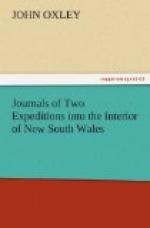By his excellency’s command,
J. T. Campbell, Secretary.
* * *
Sydney, June 12, 1819.
Sir,
In obedience to your excellency’s commands to proceed in the Lady Nelson, for the purpose of examining the entrance into Port Macquarie, and how far it would be practicable and safe for vessels of a certain description to enter it, I beg leave to report to your excellency, that I arrived off the entrance of the harbour, on the 11th of May, in company with His Majesty’s cutter, Mermaid, commanded by Lieutenant King, who expressed his intention to forward, by the superior means possessed by his vessel, the view of your excellency, relative to the harbour.
Both vessels anchored off the bar, and the day was spent in sounding the bar and channel; when we had the pleasure to find that we could enter with safety. Accordingly the next morning they were warped into the harbour, and moored alongside a natural wharf, on the south side of the port.
The examination of the harbour, and river falling therein, occupied us until the 21st, when having completed the service directed by your excellency, both vessels quitted the port with perfect ease; the Mermaid pursuing her course to the northward on her ulterior destination.
Port Macquarie is situated in latitude 31. 25. 45. S., and in longitude 152. 53. 54. E. It is a bar harbour, on which however there is at low water spring tides, at least nine feet; the tide rising from three to four feet. The true channel is perfectly straight, and the tides set so, that no danger is to be apprehended from their operation. The chief danger to be avoided on entering is a sunken rock on the south side, having about three feet on it at low water; and it will he necessary, should the port he settled, that this danger should he buoyed. The bar extends about two hundred yards; the bottom a soft sand when the water deepens to two fathoms and a half, and alternately to three fathoms, when secure anchorage will be found inside the Beacon Rock.
When vessels arrive off the bar, should the wind or tide be adverse to entering the port, good anchorage will he found in from five to eight fathoms outside the bar; Tacking Point being shut in by Peaked Hill Point. When the winds are from the south, round by the west to north, the bottom a clear sand.
The winds from north-east and south-east, if blowing strong, cause the water to break across: but as those winds are fair for entering, no danger is to be apprehended to vessels whose draft of water does not exceed nine or ten feet. Should however circumstances render it imprudent or impracticable to enter, the coast may be cleared on either tack, the indenture of the coast line not being such as to cause it ever to be a dangerous lee shore.




